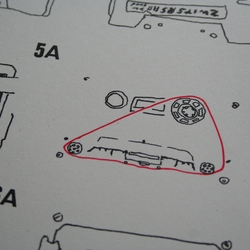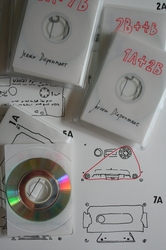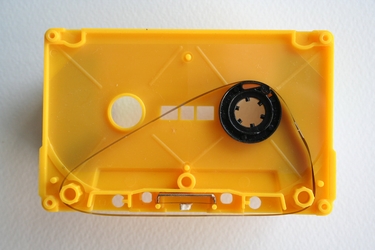 One of the more unusual items to have arrived at my door recently is Double Landscape, by Dutch “visual artist with a preference for sound” Jeroen Diepenmaat. It’s unusual insofar as it comes in the form of a small plastic wallet containing a small business card CDr – which contains just a single track, lasting just a few minutes – together with a fold-out inlay card with drawings of cassette-like images and a download code. It would have been a lot of work to go to for just a few minutes of music, and indeed the download reveals the actual entirety of the album: 84 tracks (the CDr containing just one of them) lasting a little over five hours. That’s a lot of music, but it doesn’t take long to realise that there’s a theme at play here, one that draws connections with both the Roland Kayn box set i reviewed earlier this week as well as the examples of ‘steady state’ music discussed recently.
One of the more unusual items to have arrived at my door recently is Double Landscape, by Dutch “visual artist with a preference for sound” Jeroen Diepenmaat. It’s unusual insofar as it comes in the form of a small plastic wallet containing a small business card CDr – which contains just a single track, lasting just a few minutes – together with a fold-out inlay card with drawings of cassette-like images and a download code. It would have been a lot of work to go to for just a few minutes of music, and indeed the download reveals the actual entirety of the album: 84 tracks (the CDr containing just one of them) lasting a little over five hours. That’s a lot of music, but it doesn’t take long to realise that there’s a theme at play here, one that draws connections with both the Roland Kayn box set i reviewed earlier this week as well as the examples of ‘steady state’ music discussed recently.
The Kayn connection is twofold. First, each of the 84 movements is a paradigm of the whole; the way each one behaves is, essentially identical, though the specific details are unique. Second, the range of materials used is relatively small, establishing a strong relationship between the different pieces, which are, in essence, sonic siblings. More on this in a moment. The ‘steady state’ connection is to do with this behavioural commonality, involving pairs of cycling loops. These loops are derived from a recording of Diepenmaat playing piano; this was split into seven tape loops, inserted into physical cassettes, which were then combined in pairs. Double Landscape is the product of the various possible combinations of these pairs. The cycling process of these loops quickly establishes in each piece a steady state, one that – unlike most of the examples discussed previously – has a distinct ambient quality, the resultant musical texture resulting from the coincidental ways in which the details of each loop impinge against each other. Both the serendipity of the process and the physicality of the medium are important to Diepenmaat, as he explains:
I like coincidence, so I made the rules to let the coincidence work. Besides the combinations, due to small differences in tape length the sounds move towards/apart from each other. Also tape hiss and the wear of the tape is audible in some of the tracks. I like it when it is alive like that.
 The process and its results bring to mind various other loop-based tape works, above all Asher Tuil’s 2009 Miniatures. If it lacks the enormous emotional baggage that Tuil’s album possesses, i think that’s to do with the more hands-off approach Diepenmaat has taken, simply placing loops in combination and setting them off. But this isn’t a negative criticism of Double Landscape; Tuil clearly set out to create something emotionally charged, and that’s not what’s going on here. But more importantly, the emotional baggage on a work like Miniatures is derived from the hauntological evocations and allusions it makes, and Double Landscape at times does the same thing. It’s more subtle and understated (coincidental?) yet when it occurs it’s unmistakable, just one example being the combination 2B+3A, due to the wistful, brooding collection of languid, low register chords it emphasises in conjunction with very audible tape wobble.
The process and its results bring to mind various other loop-based tape works, above all Asher Tuil’s 2009 Miniatures. If it lacks the enormous emotional baggage that Tuil’s album possesses, i think that’s to do with the more hands-off approach Diepenmaat has taken, simply placing loops in combination and setting them off. But this isn’t a negative criticism of Double Landscape; Tuil clearly set out to create something emotionally charged, and that’s not what’s going on here. But more importantly, the emotional baggage on a work like Miniatures is derived from the hauntological evocations and allusions it makes, and Double Landscape at times does the same thing. It’s more subtle and understated (coincidental?) yet when it occurs it’s unmistakable, just one example being the combination 2B+3A, due to the wistful, brooding collection of languid, low register chords it emphasises in conjunction with very audible tape wobble.
 Yet it has its own, very different, kind of baggage too. Since the entirety of Double Landscape is created from a small collection of quite short loops, the more one listens, the more echoes and memories of its earlier music appear, self-contained reference points as the basis for its own internal hauntology. These echoes are, of course, only partial, as the specific pairing of elements has not been heard before, casting new light on them and enabling them to speak in new ways. i said before it had a distinct ambient quality, and it’s this recurring of elements, and the way it plays on our half-recognition of them (it’s not always immediately clear whether in fact it’s just something similar, rather than a direct recurrence) that keeps one’s interest coming back to what might otherwise be quite ignorable loops. Not only does it strike a really nice liminal balance – such a difficult thing to do well – it establishes an environment where the music literally becomes more engaging, more involving, the longer you listen to it. It arguably only starts to make proper sense in that bigger, 84-piece context; the specific order doesn’t particularly matter, but the quantity does. As the minutes and then the hours pass, the connections become stronger, yet one’s understanding of what’s already been heard – or, more specifically, what one remembers has been heard – is continually called into question. An epic fashioned from the tiniest and simplest of musical building blocks, it’s a fascinating and engrossing experience.
Yet it has its own, very different, kind of baggage too. Since the entirety of Double Landscape is created from a small collection of quite short loops, the more one listens, the more echoes and memories of its earlier music appear, self-contained reference points as the basis for its own internal hauntology. These echoes are, of course, only partial, as the specific pairing of elements has not been heard before, casting new light on them and enabling them to speak in new ways. i said before it had a distinct ambient quality, and it’s this recurring of elements, and the way it plays on our half-recognition of them (it’s not always immediately clear whether in fact it’s just something similar, rather than a direct recurrence) that keeps one’s interest coming back to what might otherwise be quite ignorable loops. Not only does it strike a really nice liminal balance – such a difficult thing to do well – it establishes an environment where the music literally becomes more engaging, more involving, the longer you listen to it. It arguably only starts to make proper sense in that bigger, 84-piece context; the specific order doesn’t particularly matter, but the quantity does. As the minutes and then the hours pass, the connections become stronger, yet one’s understanding of what’s already been heard – or, more specifically, what one remembers has been heard – is continually called into question. An epic fashioned from the tiniest and simplest of musical building blocks, it’s a fascinating and engrossing experience.
Double Landscape is available from Jeroen Diepenmaat’s Bandcamp site, and it can be streamed below.

[…] Simon Cummings of 5against4.com wrote a very thoroughly review of my latest musical release Double Landscape. You can read it here: http://5against4.com/2017/10/21/jeroen-diepenmaat-double-landscape/ […]
Of all the things I’ve bought on your recommendation, Simon, this one took the least deliberating-over – it was love at first track! I’m quite surprised, in a way, that you like it so much, though, given your avowed aversion to Minimalism – what’s happening here could quite readily be described as a novel spin (as it were) on Reichian phasing.
i’m glad you bought it Chris – and that you like it so much. It’s an interesting point you make about minimalism. With one or two exceptions, the only minimalism i’ve ever enjoyed is the really earliest stuff – the phasing you mentioned – after which it became a hackneyed exercise in ever increasing redundancy and diminishing returns, which for me is one of the primary connotations of the term minimalism (and which for me is much more than an ‘aversion’, i utterly loathe it).
All the same, though, from my perspective the distinction between what i’ve been calling ‘steady statism’ and minimalism is enormous, even if in the case of the latter we focus only on that earliest phasing period. Early minimalism is all about following the progression of the process, over both the short- and long-term; Reich spoke of the necessity of such slow processes in order that we can properly follow it (“one of the reasons that it’s quite audible is because it’s happening extremely gradually” is how he put it in Music as a Gradual Process (1968)). Whereas what Jeroen’s doing, and steady statism generally, is establishing a very similar kind of balance between engagement and aloofness that’s at the heart of ambient thinking. (It’s worth remembering that Music for Airports, ambient’s ‘manifesto’ was created in precisely the same way.) It’s not just compositionally hands-off – setting things up and then letting them go – it’s also dialogically hands-off: the details of the process haven’t been carefully worked out in advance, and it’s not concerned with the extent to which it’s ‘connecting’ with a listener. That’s not the same as the music being ‘boring’ or not (which is a listener response), but rather the composer’s outlook and intentions (by contrast, i’m sure the minimalists would always like to think they’re being interesting and connecting with their audience, otherwise Reich’s intended gradual processes become meaningless).
This is why i don’t in any way hear steady statist music as being connected to minimalism, except in the most superficial sense of there being looping material. And after all, use of loops is hardly limited to minimalism…
Ah yes, I must confess that I was thinking purely of the mechanics of putting a piece like this together, rather than the intent behind it. Also, in fairness, the process diverges more and more from Reich’s early process as it progresses – sure, it starts off a bit like Piano Phase, but to my knowledge Reich never pre-recorded multiple permutations of that piece and jammed them together every which way, allowing the sound sources to decay organically as they (in more than one sense) played out. In the end, your point is well made that what separates what you call steady statism from 1970s Reich is a more interesting avenue for contemplation than what links the two.
Yes, though an “avenue for contemplation” (nice phrase) that allows as much for glazing over and becoming disinterested for a time (indirect contemplation?) as well as ruminating over its details (direct contemplation?).
Also, if you don’t know the Asher Tuil album i mentioned, it’s well worth checking out: https://ashertuil.bandcamp.com/album/miniatures.
If it’s anything like the Diepenmaat, it sounds like I’d better…!
Speaking of music that’s worth checking out, Steve Elcock, whom I mentioned to you via email a few weeks ago, was coincidentally in my neck of the woods this weekend, and suggested that he and I meet up for what I feel sure would have been a fascinating coffee-and-chat, but, sadly, family circumstances prevented it. Maybe next time…
Update: dipping my toe (five tracks) into the Tuil has prompted me to buy that too. Re: the associated concept of hauntology, would something like Silvestrov’s Silent Songs (more accurately translated as “Quiet Songs”, of course…but then you lose the label-friendly alliteration) fall into that bracket, do you think? For me, a similar world of powerful-but-only-half-remembered emotion is evoked in its Romantic allusions, albeit subjected to a very different “filter”, i.e. singing and playing everything sotto voce.
i’ve not actually heard the Silvestrov cycle (ECM isn’t a label that i’m drawn to very often), but i’ll check it out…